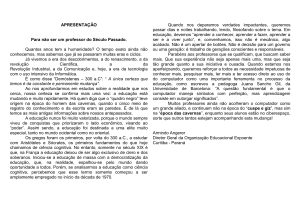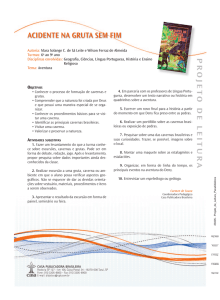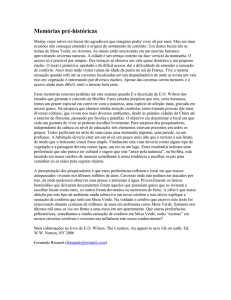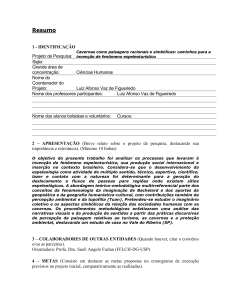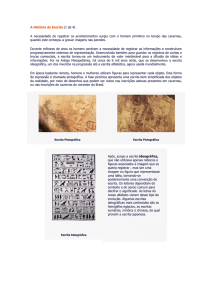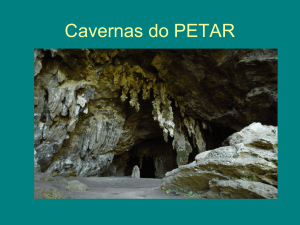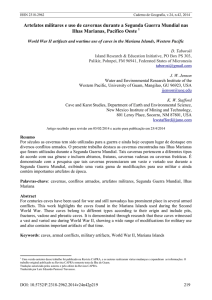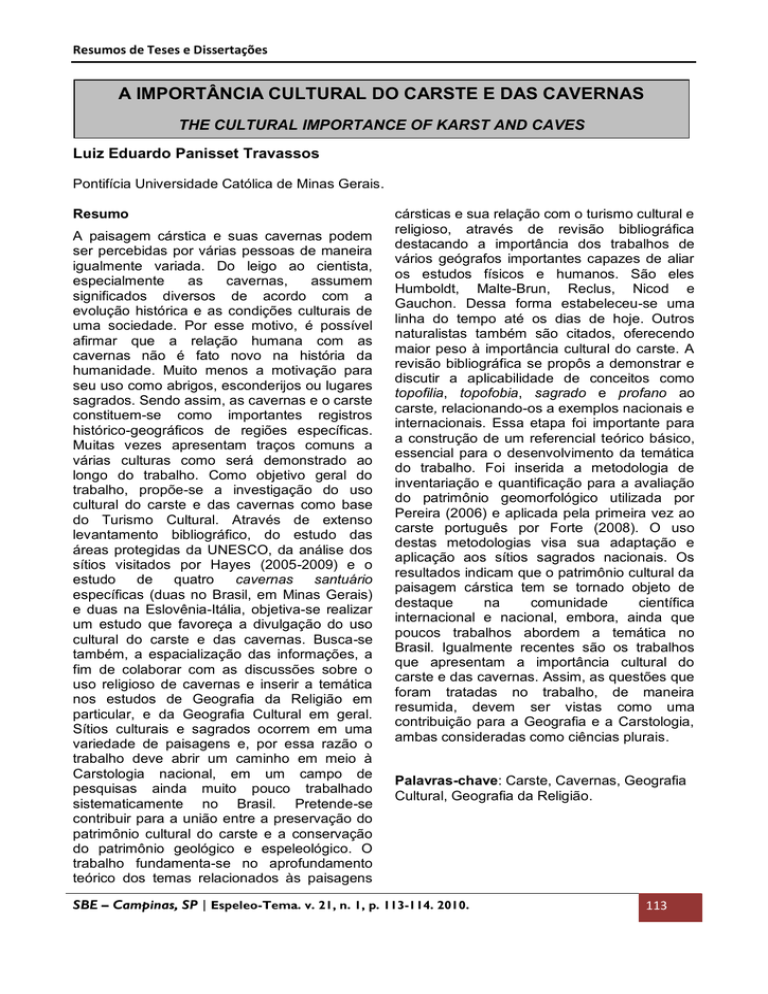
Resumos de Teses e Dissertações
A IMPORTÂNCIA CULTURAL DO CARSTE E DAS CAVERNAS
THE CULTURAL IMPORTANCE OF KARST AND CAVES
Luiz Eduardo Panisset Travassos
Pontifícia Universidade Católica de Minas Gerais.
Resumo
A paisagem cárstica e suas cavernas podem
ser percebidas por várias pessoas de maneira
igualmente variada. Do leigo ao cientista,
especialmente
as
cavernas,
assumem
significados diversos de acordo com a
evolução histórica e as condições culturais de
uma sociedade. Por esse motivo, é possível
afirmar que a relação humana com as
cavernas não é fato novo na história da
humanidade. Muito menos a motivação para
seu uso como abrigos, esconderijos ou lugares
sagrados. Sendo assim, as cavernas e o carste
constituem-se como importantes registros
histórico-geográficos de regiões específicas.
Muitas vezes apresentam traços comuns a
várias culturas como será demonstrado ao
longo do trabalho. Como objetivo geral do
trabalho, propõe-se a investigação do uso
cultural do carste e das cavernas como base
do Turismo Cultural. Através de extenso
levantamento bibliográfico, do estudo das
áreas protegidas da UNESCO, da análise dos
sítios visitados por Hayes (2005-2009) e o
estudo de quatro
cavernas santuário
específicas (duas no Brasil, em Minas Gerais)
e duas na Eslovênia-Itália, objetiva-se realizar
um estudo que favoreça a divulgação do uso
cultural do carste e das cavernas. Busca-se
também, a espacialização das informações, a
fim de colaborar com as discussões sobre o
uso religioso de cavernas e inserir a temática
nos estudos de Geografia da Religião em
particular, e da Geografia Cultural em geral.
Sítios culturais e sagrados ocorrem em uma
variedade de paisagens e, por essa razão o
trabalho deve abrir um caminho em meio à
Carstologia nacional, em um campo de
pesquisas ainda muito pouco trabalhado
sistematicamente no Brasil. Pretende-se
contribuir para a união entre a preservação do
patrimônio cultural do carste e a conservação
do patrimônio geológico e espeleológico. O
trabalho fundamenta-se no aprofundamento
teórico dos temas relacionados às paisagens
cársticas e sua relação com o turismo cultural e
religioso, através de revisão bibliográfica
destacando a importância dos trabalhos de
vários geógrafos importantes capazes de aliar
os estudos físicos e humanos. São eles
Humboldt, Malte-Brun, Reclus, Nicod e
Gauchon. Dessa forma estabeleceu-se uma
linha do tempo até os dias de hoje. Outros
naturalistas também são citados, oferecendo
maior peso à importância cultural do carste. A
revisão bibliográfica se propôs a demonstrar e
discutir a aplicabilidade de conceitos como
topofilia, topofobia, sagrado e profano ao
carste, relacionando-os a exemplos nacionais e
internacionais. Essa etapa foi importante para
a construção de um referencial teórico básico,
essencial para o desenvolvimento da temática
do trabalho. Foi inserida a metodologia de
inventariação e quantificação para a avaliação
do patrimônio geomorfológico utilizada por
Pereira (2006) e aplicada pela primeira vez ao
carste português por Forte (2008). O uso
destas metodologias visa sua adaptação e
aplicação aos sítios sagrados nacionais. Os
resultados indicam que o patrimônio cultural da
paisagem cárstica tem se tornado objeto de
destaque
na
comunidade
científica
internacional e nacional, embora, ainda que
poucos trabalhos abordem a temática no
Brasil. Igualmente recentes são os trabalhos
que apresentam a importância cultural do
carste e das cavernas. Assim, as questões que
foram tratadas no trabalho, de maneira
resumida, devem ser vistas como uma
contribuição para a Geografia e a Carstologia,
ambas consideradas como ciências plurais.
Palavras-chave: Carste, Cavernas, Geografia
Cultural, Geografia da Religião.
SBE – Campinas, SP | Espeleo-Tema. v. 21, n. 1, p. 113-114. 2010.
113
Resumos de Teses e Dissertações
Abstract
The karst landscape and the caves can be
perceived by several people in an equally
varied way. From the layman to the scientist,
especially caves, assume different meanings
according to historical and cultural conditions of
a particular society. Therefore, one can say that
the human relationship with caves is not really
new in the history of mankind. It is also not less
new the motivation for their use as shelters,
safe houses and sacred places. Thus, caves
and karst are important historical and
geographic records of specific regions. Often
they present common features of various
cultures as shown throughout this work. As a
general objective of this research, it is
proposed the investigation of the cultural use of
karst and caves based on the Cultural Tourism.
Through extensive literature review, study of
the areas protected by UNESCO, the analysis
of the sites visited by Hayes (2005-2009) and
the study of four specific cave shrines (two in
Brazil, in Minas Gerais) and two in SloveniaItaly the objective is to undertake a study that
helps to promote the dissemination of the
cultural use of karst and caves. It is also
intended to spatialize the information and
contribute to the discussions on the religious
use of caves and insert this topic in the studies
of the geography of religion in particular and of
the Cultural Geography in general. Sacred and
cultural sites occur in a variety of landscapes
and, thus, the research should help to start the
discussions through the national karstology in a
field of study which is still very little researched
systematically in Brazil. It is also intended to
make a contribution to the union between the
preservation of cultural heritage and the
conservation of the karst geological heritage
and its caves. The work is also based on
deeper theoretical issues related to karst
landscapes and their relation to the cultural and
religious tourism, based on a bibliographical
review highlighting the importance of the work
of several important geographers who
combined the physical and human studies.
They were Humboldt, Malte-Brun, Reclus,
Nicod, and Gauchon. Thus it was established a
timeline to the present day. Other naturalists
are also mentioned, giving a greater meaning
to the cultural importance of karst and caves.
The literature review aimed to demonstrate and
discuss the applicability of concepts such as
topophilia, topophobia, sacred and profane
applied to the karst, linking them to national
and international examples. This step was
important for the construction of a theoretical
base which was essential for the development
of the research thematic. While developing the
work,
the
researcher
introduced
the
methodology
of
inventariation
and
quantification for the evaluation of the
geomorphological patrimony used by Pereira
(2006) and first applied to the Portuguese karst
by Forte (2008) to the Brazilian sacred sites.
The results indicate that the cultural heritage of
the karst landscape has become a source of
distinction in the international and national
scientific community, though, yet little work on
the theme is made nationally. Equally recent
are the works that present the cultural
importance of karst and caves. Thus, the
issues that were treated in the research should
be seen as a contribution to Geography and
Karstology, both considered as plural sciences.
Keywords: Karst, Caves, Cultural Geography,
Geography of Religion.
Orientadores/Advisors: Prof. Dr. Oswaldo Bueno Amorim Filho & Prof. Dr. Andrej Kranjc.
Referência
TRAVASSOS, Luiz Eduardo Panisset. A importância cultural do carste e das cavernas. 2010.
372f. Tese (Doutorado). Pontifícia Universidade Católica de Minas Gerais.
A revista Espeleo-Tema é uma publicação da Sociedade Brasileira de Espeleologia (SBE).
Para submissão de artigos ou consulta aos já publicados visite:
www.sbe.com.br/espeleo-tema.asp
114
Espeleo-Tema. v. 21, n. 1, p. 113-114. 2010.| SBE – Campinas, SP

